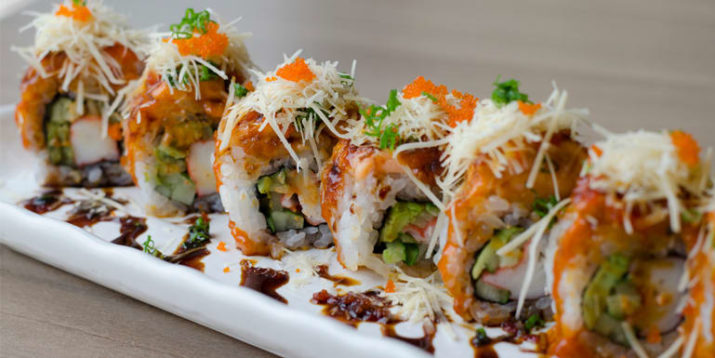Is Sushi Healthy?

The long and short: It depends. Sushi can be a nutrient-dense, power-packed meal that’s high in protein. But, if you’re not careful, it can be a significant source of unhealthy fats, sodium, and calories.
I mean, we get it. Sushi can seem like a healthy go-to; it’s fish, rice, and seaweed, right? True. But, like many other cuisines, the traditional version is subject to Western culinary interpretation. Soy sauce too plain? Amp it up with some sugar-spiked brown glaze. Raw fish unappetizing? Coat it with breading and drop it in the deep-fryer. Roe too strange to top a roll with? Add texture with deep-fried panko flakes.
Of course, sushi comes in all shapes and sizes and can vary greatly from restaurant to restaurant. Energy-wise, we’re talking 150–600+ calories per roll, and that’s without the brown glazes, cream cheese, or mayonnaise-laden fillings. A basic spicy tuna roll, for instance, is made with tuna, rice, seaweed, sriracha, and mayo and weighs in at about 290 calories.
Also, let’s keep it real: Who eats just one roll of sushi for dinner?! That’s like ordering a small salad with dressing on the side, and then gobbling half of your date’s fries.
To keep sushi from becoming a diet buster, follow these tips when ordering your next roll:
Go brown. Ask for your sushi to be made with brown instead of white rice. Brown rice is higher in fiber (to keep you regular) and lower on the glycemic index, meaning it won’t spike your blood sugar as much as the white stuff. According to Chef Bobby Calabrese from the new cooking show FIXATE, starring 21 Day Fix celebrity trainer Autumn Calabrese, “Many people use brown rice as a substitute, which is good, but we took it a step further and designed a quinoa-based sushi roll that is a perfect match for [Beachbody’s] nutritional goals.”
One roll of sushi can contain up to 1 cup of rice, which adds about 160 calories and 37 grams of carbohydrates. Again, we feel you on the more-than-one-roll thing. We know you don’t have the appetite of a toddler. Keep reading for our portion control tip.
Skip the sauce. Spicy mayo, eel sauce, soy sauce, oh my. The fat, sugar, and salt adds up when sushi is topped with condiments. You’re almost heading into cheeseburger territory if you get all the saucy, creamy, crunchy bells and whistles. To keep it light, go easy on the sauces and opt for ginger and wasabi. Dip — don’t dunk — your roll or nigiri in lower-sodium soy sauce (the one with the green top) to slash some sodium.
Eat protein. Many fishes can be excellent sources of protein, but to get the biggest bang for your buck, choose omega-3 rich fish like salmon, tuna, mackerel, and eel. These fatty fishes are among the few sources of vitamin D in the diet. If you’re squeamish (or pregnant), stay away from raw and choose steamed or grilled sushi over fried (aka “tempura”) options.
Control portions. Keep portions in check by ordering one roll, and add a healthy appetizer or two to satisfy your appetite. A roll of sushi contains about six pieces of fish, ranging from 25–100 calories per bite! If you’re still hungry after one roll, add some ginger or seaweed salad, edamame, or miso soup. Some sashimi — simple slices of raw fish — can also help fill the belly.
Opt for healthy fats. Fats help to keep you full, but not all are created equal. Choose sushi rolls with avocado, and skip the ones with cream cheese, mayo, eel sauce, and those fried in oil. We know these can be the temptresses of the sushi bar, but once you get used to eating less gussied up Japanese fare, those wacky rolls will start to look like celebrities who wear too much makeup.
Up the veg. To get more filling vegetables in, order a veggie sushi roll (they’re usually lower calorie, too). Traditional veggie sushi is filled with cucumber, carrots, and avocado. Please your palate with extra pizzazz from rolls, called futomaki, made with pickled vegetables.
So yes, sushi can be healthy… if you’re savvy about how you order.
